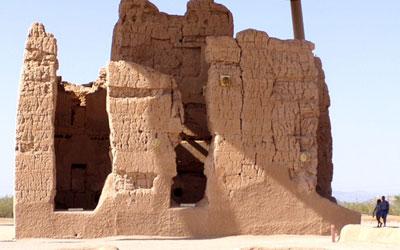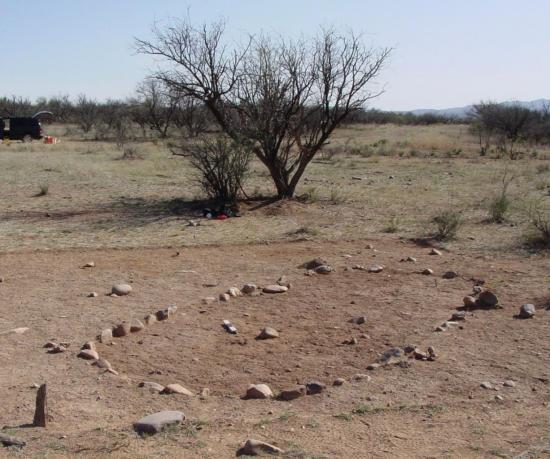Blake de Pastino
Source - http://westerndigs.org/new-discoveries-in-arizona-may-be-game-changers-in-mystery-of-ancient-cultures-collapse/
The remains of houses, bits of charcoal, and rarely seen types of pottery are tantalizing new clues in one of the more persistent mysteries of Southwestern history: What happened to the culture known as the Hohokam?
Best known for their hulking adobe complexes, like the ruins now called Casa Grande, the Hohokam were one of the Southwest’s most complex and influential societies, constructing irrigation canals that turned parts of the Sonoran Desert into farmland, and trading with distant Mesoamerican cultures whose influence can still be seen in Hohokam ball courts.

The caliche “Big House” at Casa Grande Ruins in Arizona was built near the zenith of the Hohokam culture in the 14th century.
By the late 1300s, the Hohokam were perhaps the most populous cultural group in the Southwest. But around this time, something triggered their precipitous decline.
While the cause — or, more likely, series of causes — remains poorly understood, Dr. Deni Seymour says she has turned up an important clue: Despite what most scientists have believed for decades, the Hohokam were not alone.
Years of research in southeastern Arizona, the heart of the Hohokam homeland, have turned up what Seymour calls “abundant evidence” that another tribal group — the O’odham, whose members still call Arizona home today — lived in the region perhaps as early as the 1100s.
This flies in the face of scientific convention, which has held that the region was essentially vacant between the fall of the Hohokam in the late 1300s and the arrival of the first Spanish missionaries in the mid-1500s.
“Some of the big questions scholars have been asking for a very long time are: What happened to the Hohokam? Is there a relationship between the Hohokam and the O’odham? In other words, did the Hohokam become the O’odham?” said Seymour, an archaeologist with the Jornada Research Institute in New Mexico, and a specialist in early O’odham and Apache cultures.
“Until now we have not had enough information on the O’odham — historically, the Upper Pima — to address this question from an archaeological standpoint. Now we do.”
In a paper recently published in the Old Pueblo Archaeology Bulletin, Seymour describes her investigations of sites inhabited by a people known as the Sobaípuri, a branch of the O’odham whose descendants are now part of the Tohono O’odham.
Their traces are found mostly along the San Pedro, Santa Cruz, and Gila rivers in southeastern Arizona, where the Sobaípuri irrigated crops and constructed settlements in rows of elongated houses.

Artifacts found among the ruins of a Sobaipuri house at Sonoita Creek, Arizona, testify to the tribal group’s presence around the time of the Hohokam’s collapse, according to a new study. (Photo courtesy Dr. Deni Seymour)
Some of the sites had been excavated before, in the 1950s and ’60s, revealing evidence of the Sobaípuri’s signature oblong building style and plainware pottery. But, using ethnographic accounts, historical records, and the dating technology available at the time, most experts estimated that the Sobaípuri lived in Arizona no earlier than the 1540s, around the time that the Spanish arrived.
For her research, however, Seymour turned to new methods. One of them, called thermoluminescence, can pinpoint the last time a material was heated to a certain temperature; another, optically stimulated luminescence, can isolate when particles like quartz or feldspar were last exposed to light.
Together these technologies can help date objects like cooking pits, identify when pottery was fired, and determine how long some sediments have been buried.
Using this suite of techniques and radiocarbon dating, Seymour said, the more samples she looked at, the more “unusual and unexpected” the results became.
At one settlement near a tributary of the Santa Cruz known as Sonoita Creek, fragments of Sobaípuri pottery dated by luminescence, as well as carbon-14 dating of charcoal, yielded dates from the 1400s.
“This site dated 150 to 200 years earlier than anyone was saying, so I was very surprised,” she said.
At another nearby site, sherds of more Sobaípuri pottery were similarly dated to the 15th century.
These and other locations also turned up plainware that was made by the Sobaípuri but had been traded to other, mobile groups. Some of these pieces, too, dated to the 1400s.
It was when Seymour and her team began testing samples from the San Pedro valley, however, that they found themselves going back even deeper in time.
At the ruins of a settlement known as Santa Cruz de Gaybanipitea, a collection of pottery sherds returned dates in the late 1200s. And in another nearby site, a separate set was dated to around 1150.
“These dates are game changers,” Seymour said. “These allow us to really understand some new things that have previously presented us with interpretative roadblocks.”
At the very least, she noted, these findings suggest that the timeline of occupation in the far Southwest may need to be rethought, with the O’odham inhabiting the region centuries earlier than had been thought — and perhaps more importantly, with their occupation coinciding with the waning days of the Hohokam.

These sherds of Sobaipuri pottery, done in a style known as Whetstone Plain, have been dated to the 13th century — some 300 to 400 years before many archaeologists thought the culture lived in Arizona. (Photo courtesy Deni Seymour)
If the Sobaípuri lived in southern Arizona before, during and after the Hohokam collapse, she said, it becomes more likely that that they had some kind of role in, if not the collapse itself, then at least its aftermath, such as absorbing some of the Hohokam into their communities.
“With abundant evidence of dated Sobaípuri settlements along both the San Pedro and Santa Cruz rivers [before the 1500s], we can say with relative certainty that the Sobaípuri were present at the end of the Hohokam period, and that they either replaced the Hohokam, absorbed them, or represent a modified form of them — all consistent with oral traditions,” she said.
Such a scenario would explain, for example, accounts shared by many modern O’odham of an ancient people moving into the region and “chasing out” the Hohokam, Seymour said, as well as the locally held belief that the O’odham are related to the Hohokam.
Of course, there’s no evidence of any O’odham group, including the Sobaípuri, playing a direct role in the decline of the Hohokam, she cautioned.
But more investigation into the Sobaípuri and other groups will help clarify the muddled timeline that still surrounds the collapse of the culture that built Casa Grande.
“Archaeologists are by nature skeptical — it’s in our training — so many will simply think there is something wrong with the dating, the sample, or whatever,” Seymour said.
“But those who are open minded and genuinely curious will be as excited as I am about these new dates and their implications.”
Sources:
• “Dating the Sobaípuri: A Case Study in Chronology Building and Archaeological Interpretation,”Old Pueblo Archaeology Center Bulletin, No. 67
• Where the Earth and Sky Are Sewn Together: Sobaipuri-O’odham Contexts of Contact and Colonialism, by Deni J. Seymour, University of Utah Press (2011)